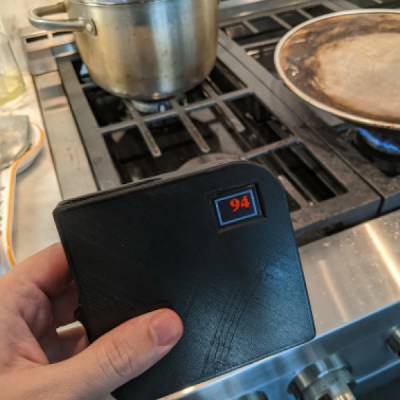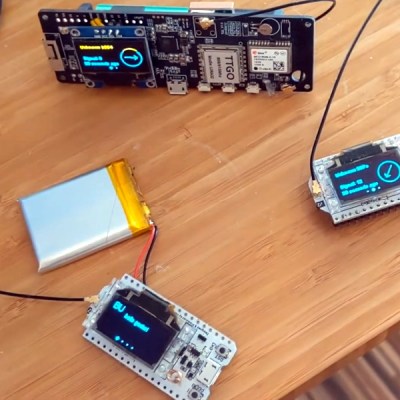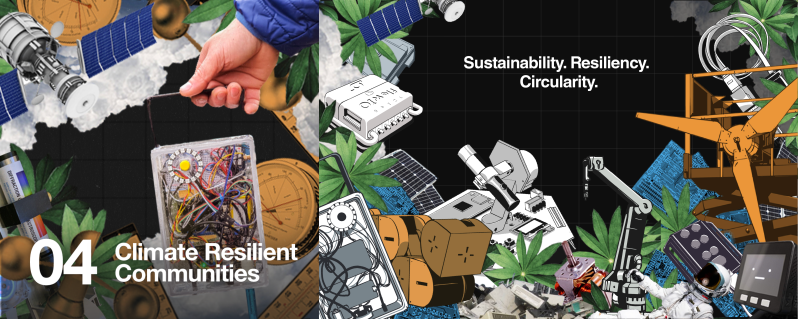Following along with the 2022 Hackaday Prize theme on building a better world by doing what we all do best – hacking together solutions – the fourth round of the Prize focuses on making our local communities more resilient against and sensitive to severe weather and environmental disasters. Whether it’s an early warning system for wildfires or a distributed communication network that will keep working even when the cell phone service goes down, we’re challenging you to help make your world safer by reacting sooner and better. Get your project entered now!
Sensing
 We love systems that help us monitor our environments, and not just for idle curiosity or citizen science. Sometimes it’s critical. We’ve seen monitors aimed at giving you a personal particulate air quality indicator, especially helpful for people with respiratory problems when downstream of a forest fire.
We love systems that help us monitor our environments, and not just for idle curiosity or citizen science. Sometimes it’s critical. We’ve seen monitors aimed at giving you a personal particulate air quality indicator, especially helpful for people with respiratory problems when downstream of a forest fire.
But even better is networking these together to generate an air quality map, or to log long-run trends over time and space. CanAirIO, for instance, has both a fixed and mobile unit that can help map out CO2 and particulate matter quality. Or maybe it’s not wildfires that invade your airspace, but rather pollution from car use. We’ve seen projects like that before too, and anything along these lines would make a great entry into this challenge round. Could you predict local air quality?
Basically anything that helps quantify the quality of your environment, whether single, distributed, or mobile, whether for emergency use or to help promote positive change on a chronic problem, can help make your community stronger against weather and environmental adversity, would be a great entry this round.
Communication
 Warning and monitoring are great, but when the emergency event happens, it’s great to be prepared. So we’re also taking entries that focus on building up emergency infrastructure when the water rises or when the fires hit. We’ve seen many versions of local mesh networks along the lines of Meshtastic, the LoRa QWERTY Messenger, and even QMesh which aims at voice comms. We want to see more! And we want to see one of them break out.
Warning and monitoring are great, but when the emergency event happens, it’s great to be prepared. So we’re also taking entries that focus on building up emergency infrastructure when the water rises or when the fires hit. We’ve seen many versions of local mesh networks along the lines of Meshtastic, the LoRa QWERTY Messenger, and even QMesh which aims at voice comms. We want to see more! And we want to see one of them break out.
This is a great challenge for those who like to think bigger than just the one-off project. The goal is to enable an entire community to share environmental information or react gracefully to extreme weather events, and that means thinking about how to build up a network of people and not just devices. Your awesome mesh protocol doesn’t help if you’re the only one with a radio. We know it’s a stretch goal, but the best projects here will have at least the start of a community-building aspect to them. After all, this is about helping others.
Enter Your Project
The Climate Resilient Communities challenge starts right now, and runs until September 4th. As with all the other rounds, we’ll have ten $500 prizes for each finalist, and the best projects will have a chance at the overall 2022 Hackaday Prize. Get hacking!

















Hmmm massive Carrington event survival information service.. drum from a clothes dryer, encoded with pegs, that operate a semaphore tower, that can be seen in a 5 mile radius with optical aids (Binoculars) that can send the text of wikipedia articles about water purification, and other essentials…. driven by a couple of repurposed bicycles… … 3.5kb of text per washing machine drum… okay nah…. auxettophone powered by foot pump to repurposed hot water boiler tank, reading emergency info off a pre-mastered LP… okay upgrade, wind pump powered….
Note to self, use ceramic or polymer bearings or as the bridge between metal parts they miiiiight weld themselves together in a sufficiently massive event.
A Carrington event won’t damage very much. Also, anything turned off will be unaffected.
The complete Carrington event survival guide: turn it off, wait 10 minutes, turn it back on.
Anything turned off and shielded will be unaffected. The EM emission is across the whole spectrum, the only “sensitive stuff” in the Carrington storm happened also to be connected to miles of telegraph wire, which maybe actually damped higher frequency effects directly on the equipment itself. Also it is thought that the Sun can twiddle the knob up 4 or 5 orders of magnitude higher. Anyway, you turn back on your stuff, get a few hours out of it’s battery and then what do you plug it into, just Carrington level is gonna take 6 months to get everything back to merely a Texas level of service, to bring it all back up to 21st century standards in the civilised world will take another 4 years.
We’ll know it’s coming, from sensor satellites sunward.
More interconnected regions will be worse affected, but if the politicians don’t interfere the engineers will shed load prior so the ends of the long transmission lines can be grounded and transformers disconnected.
Even the eastern interconnect should be able to ride through it (hopefully won’t be interconnected at the moment of impact). ERCOT will be OK, being much less dependent on interchange.
That all depends on politicians shutting up and letter those that know, do. Might be much worse. Grandstanding useless lawyers just can’t shut up.
Anybody know does FERC (or others) have any written plans?
Saw a dumb as F brit show about this on prime, it that the politicians were the saviors. Deluded.
Semaphore tower! :)
But a solar flare / CME detector / warner would be cool. Get to mix in a nice telescope…
“Semaphore tower”
NFG at all! They are prone to fire damage due all the sulfur potential user may have.
The clacks?
I got that reference!
Who are you going to get to operate the clacks though?
the goblins of course